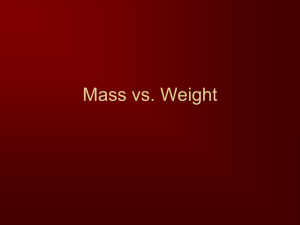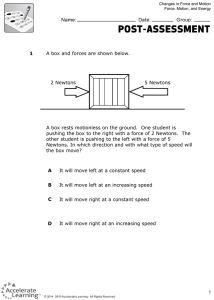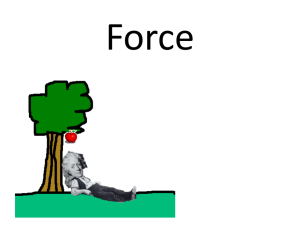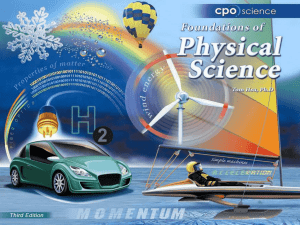vol4sample2 - Chartwell
advertisement
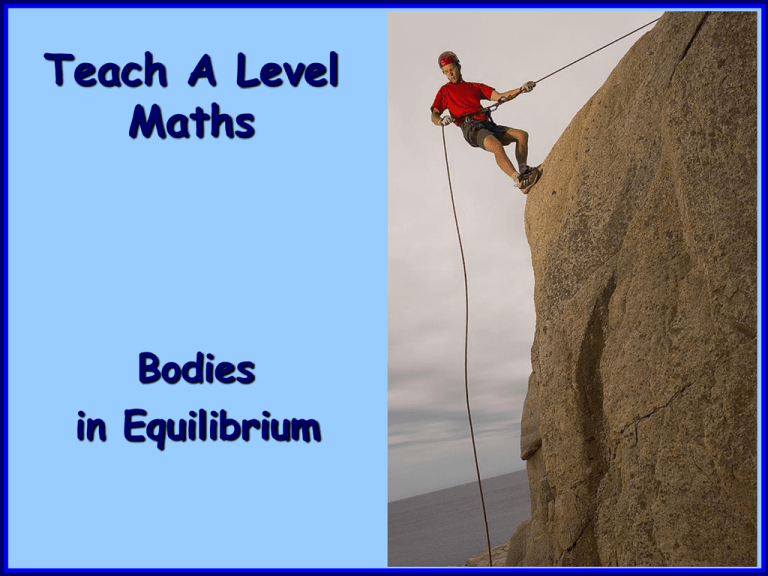
Teach A Level Maths Bodies in Equilibrium Volume 4: Mechanics 1 Bodies in Equilibrium "Certain images and/or photos on this presentation are the copyrighted property of JupiterImages and are being used with permission under license. These images and/or photos may not be copied or downloaded without permission from JupiterImages" © Christine Crisp We have used 2 methods for solving problems with 3 forces in equilibrium: using a triangle of forces, finding the components of the forces by resolving. However, if we have more than 3 forces, or the forces are not in equilibrium, we cannot use a triangle of forces, so we then resolve the forces. Since the method of resolving forces can be applied to any of these problems, we’ll use it in the following examples. e.g.1. The diagram shows a particle of weight of 2 newtons that is tied to a light inextensible string attached to a wall. The particle is held in equilibrium, as shown, by a horizontal force of magnitude P newtons. Find the tension in the string and the value of P. 40 T P 2 Solution: The first step is to show the forces acting on the particle. Equilibrium. Find T and P. Resolving: 40 Tcos 40- 2 = 0 T P Decide with your We never should Tcos 40 miss =partner 2 out what the of T so is,leads without this component stage as doing T = cos2 40 diagram. todrawing errors ainseparate later problems. = 2·61 ( 3 s.f. ) 2 across the angle The tension is 2·61 newtons. means cos P - Tsin 40 = 0 P = Tsin 40 P = 2·61sin 40 P = 1·68 newtons ( 3 s.f. ) e.g.2. A particle of weight 10 newtons rests on a smooth plane inclined at 35 to the horizontal. 35 The particle is supported, in equilibrium, by a light inextensible string parallel to the slope. Find the magnitudes of the tension in the string and the contact force between the particle and plane. R T Equilibrium Smooth plane Weight 10 newtons. 35 10 Find T and R. Solution: Agree with your partner which directions you would use to thesmooth forces. Theresolve plane is so there is no friction. Ans: There are 2 reasons for preferring parallel and perpendicular to the plane: • We will only need to resolve 1 force, the weight. • T will appear in one equation and R in the other, so we won’t have to solve simultaneous equations. R T 35 55 35 10 35 To find the components of the weight, we need an angle. Using this right angled triangle . . . the 3rd angle is 90 - 35 = 55 and using the right angle between the slope and the perpendicular, 90 - 55 = 35 R T 35 55 35 10 35 We can just use 35 ( the angle of the slope ) without needing to subtract. Solution: Find T and R. R T 35 35 35 10cos 35 10 10 10sin 35 Resolving: T - 10sin 35 = 0 T = 10sin 35 = 5·74 newtons ( 3 s.f. ) R - 10 cos 35 = 0 R = 10 cos 35 = 8·19 newtons ( 3 s.f. ) Tip: Lots of problems you will meet in M1 involve objects on slopes so it is well worth remembering the component of the weight down the slope: Component of W down the slope : W sin a a W e.g.3 A box of weight 10 newtons is being pushed at a constant speed in a straight line across a horizontal surface by a force of magnitude P newtons at 25 to the surface. There is a constant resisting force of magnitude 14 newtons. Find P and the magnitude of the normal reaction. Solution: P 14 R 25 10 Constant velocity equilibrium Can you see what the horizontal component of the pushing force is, without drawing a separate diagram ? Ans: Pcos 25 e.g.3 A box of weight 10 newtons is being pushed at a constant speed in a straight line across a horizontal surface by a force of magnitude P newtons at 25 to the surface. There is a constant resisting force of magnitude 14 newtons. Find P and the magnitude of the normal reaction. Solution: R P Resolving: 14 Pcos 25 - 14 = 0 25 10 14 cos 25 P = 15·4 ( 3 s.f. ) P = R - 10 - Psin 25 = 0 R = 10 + 15·4sin 25 = 16·5 newtons ( 3 s.f. ) SUMMARY A body in equilibrium is either at rest or moving with a constant velocity. To solve equilibrium problems we resolve the forces and form equation(s) using X = 0 and/or Y = 0. For bodies on a slope we usually resolve parallel and perpendicular to the slope. The component of the weight, W, down a slope is W sin a where a is the angle of the slope. EXERCISE 1. A particle of weight 2 newtons rests on a smooth plane inclined at 42 to the horizontal. It is supported by a force of magnitude P newtons acting parallel to the slope. P 42 2 Find the value of P and the magnitude of the normal reaction. EXERCISE Solution: R 42 Resolving: P 2 P - 2sin 42 = 0 P = 2sin 42 = 1·34 ( 3 s.f. ) R - 2cos 42 = 0 R = 2cos 42 = 1·49 newtons ( 3 s.f. ) EXERCISE 2. A particle of weight W is held in equilibrium by two inextensible strings AC and BC at 60 and 30 to the horizontal as shown in the diagram. A B 60 C 30 If the tension in BC is 1 newton, find the value of W and the tension in AC. EXERCISE Solution: A B T 1 60 30 C W Method 1: Resolving horizontally and vertically 1 cos 30 - T cos 60 = 0 -T cos 60 = -cos 30 T = cos 30 cos 60 T = 1·73 ( 3 s.f. ) 1 sin 30 + T sin 60 - W = 0 1 sin 30 + 1·73 sin 60 = W W =2 The weight is 2 newtons and the tension in AC is 1·73 newtons. EXERCISE Solution: A B T 1 60 60 30 C W Method 2: Resolving parallel and perpendicular to CB 1 - W cos 60 = 0 1 = Wcos 60 1 =W cos 60 W =2 T - W sin 60 = 0 T = 2sin60 W = 1·73 ( 3 s.f. ) The weight is 2 newtons and the tension in AC is 1·73 newtons. The following page contains the summary in a form suitable for photocopying. TEACH A LEVEL MATHS – MECHANICS 1 BODIES IN EQUILIBRIUM Summary A body in equilibrium is either at rest or moving with a constant velocity. To solve equilibrium problems we resolve the forces and form equation(s) using X = 0 and/or Y = 0. For bodies on a slope we usually resolve parallel and perpendicular to the slope. The component of the weight, angle of the slope. W, down a slope is W sin a , where a is the
